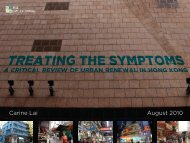Untitled - Civic Exchange
Untitled - Civic Exchange
Untitled - Civic Exchange
Create successful ePaper yourself
Turn your PDF publications into a flip-book with our unique Google optimized e-Paper software.
Chapter 2:<br />
Is Hong Kong's Transport System Sustainable<br />
that more people will experience even higher levels of noise for more hours of the day and night.<br />
Meanwhile, mobility will continue to deteriorate, with road speeds as low 14 km per hour by 2016. The<br />
underlying problem is the need to accommodate the transport demands of an additional one to two million<br />
people over the next one and a half decades.<br />
Therefore, Hong Kong transport also fails the second test of sustainability given in Chapter 1. In the<br />
face of expected changes, service levels are projected to decline, while unacceptable external costs<br />
will persist and indeed, increase.<br />
In other words, Hong Kong's current transport system is not sustainable and current government<br />
plans will fail to make it so.<br />
2.3 Evolving transport objectives<br />
Hong Kong's cityscape took shape in the mid-1960s when Hong Kong began to study its internal transport<br />
needs in a systematic manner in response to population and economic growth. A number of important<br />
studies, notably the Hong Kong Mass Transport Study (1967), the Long Term Road Study (1968), the three<br />
territory-wide comprehensive transport studies (1976, 1989, and 1999), and the two white papers on<br />
internal transport in Hong Kong (1979 and 1990) represent the foundation of Hong Kong's current<br />
transport system. The first White Paper on Internal Transport Policy, published in 1979, defined Hong<br />
Kong's first official transport objective:<br />
"The Government's central transport objective is to maintain and improve the mobility of<br />
people and goods." 42<br />
Later publications essentially restate this original objective. In essence, the government aims to achieve an<br />
acceptable level of mobility for both passengers and freight in order to satisfy the transport demand<br />
generated by economic growth and urban development.<br />
The 1979 White Paper also identified three main principles of transport policy in meeting this objective:<br />
• Improvement of the road system;<br />
• Expansion and improvement of public transport; and<br />
• More economic use of the road system.<br />
Planning for sustainability<br />
Questions have long been raised as to the sustainability of Hong Kong's transport system. However, it was<br />
not until 1997 that transport officials acknowledged that they had the responsibility to achieve a sustainable<br />
transport system and modified Hong Kong's transport objectives by noting that transport policy should take<br />
environmental issues into account. Up to this point, the Transport Bureau did not consider sustainability<br />
factors when planning Hong Kong's transport system and regarded environmental protection simply as a<br />
matter of pollution control, which was the job of another government unit.<br />
42 Environment Branch, Government Secretariat (1979), Keeping Hong Kong Moving: The White Paper on Internal<br />
Transport Policy, Hong Kong: HKSAR Government, p.6.<br />
15

















